INTRODUCTION U. Frey*, J. Gerritsen # *Paediatric Respiratory Medicine, Dept of Paediatrics, University of Berne, 3010 Inselspital, Bern, Switzerland. Fax: 41 316329484 E-mail: urs.frey@insel.ch. # Beatrix Children’s Hospital, University Medical Centre Groningen, Groningen, The Netherlands. Fax: 31 503614235 E-mail: j.gerritsen@med.umcg.nl Paediatric respiratory medicine is a growing and continuously changing field with an increasing impact for many adult respiratory diseases. The field is so large that it is impossible to cover all aspects in one issue of this series. Therefore, the current Monograph focuses on a few important topics. With increasing pollution and a particular susceptibility of children to these environmental toxins, as well as changing lifestyles in the Western world, lung problems in children have become a major health issue. Many of these environmental factors will not only have an immediate effect on children’s health, but may also have a long-lasting impact on their growth and development. Whether this will result in a change in respiratory morbidity in adults in the future is still not very well known. For these reasons, the first few chapters of this Monograph focus on the developmental aspects of paediatric respiratory diseases.Theimpactofgeneticandenvironmentalfactors,andtheirinteractionwithgrowth and structural development of the lung and with immune and allergy development in children, is discussed. This includes the impact of remodelling on lung growth. In the following chapters, new diagnostic ideas are provided for the paediatric respiratory clinician. Over the past few years, there has been a growing body of literature presenting new diagnostic techniques to assess lung function, inflammatory and allergic markers of lung disease in the outpatient clinic and in paediatric intensive care units. However, it is getting increasingly difficult to decide whether these techniques are clinically relevant and how they should be used and interpreted. This is followed by a discussion of the major disease groups in paediatric respiratory medicine, including the increasingly important problem of childhood adipositas and its impact on the respiratory system. The final chapter of the Monograph provides a summary on new approaches of how to examine and perhaps better understand complex respiratory disease with its multitude of influencing factors, interactions and impact on growth and development. Such new concepts have been frequently used in statistical physics and have begun to find their way into natural sciences. A large amount of summaries and reviews on each of these particular fields and many up-to-date textbooks have been published recently. It was decided that there is no need for another "ordinary" textbook, which can never be complete and cover all aspects of a particular field. Many authors have supported the idea that the current Monograph should be more conceptual and visionary. Thus, the authors were asked to focus on the four main following questions: 1) What have been the most recent fundamental developments in your field? 2) What are the current models and concepts of the pathophysiological mechanisms, the related diseases and the treatment strategies? 3) What are the important future questions? and 4) What is needed to find answers on these questions? The Guest Editors have aimed to form author teams of experienced and innovative people in the field who can come up with new concepts and ideas. These concepts should inspire clinicians to critically re-evaluate their strategies, but should also stimulate young researchers. The Guest Editors hope that you will like the concept of this Monograph, and think that this issue is similarly interesting for adult respiratory specialists who should be increasingly interested in the early paediatric origins of respiratory disease. Eur Respir Mon, 2006, 37, ix. Printed in UK - all rights reserved. Copyright ERS Journals Ltd 2006 European Respiratory Monograph ISSN 1025-448x. ix
